Water poverty on U.S. soil: why the Navajo Nation water crisis should shame us all
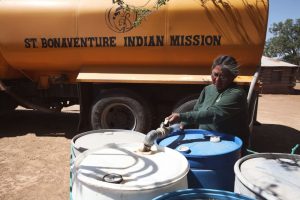
CBS Sunday Morning News recently ran a cover story titled The Water Lady: A savior among the Navajo about Darlene Arviso, a Saint Bonaventure Indian Mission employee that brings water to Navajo Nation. This story brought to light the fact that 40% of the 173,000 residents of Navajo Nation lack access to clean, safe drinking water. Along with many others in the water industry, we here at Tata & Howard were aghast and aggrieved. After all, we are all very familiar with the 100% improved water and sanitation statistic that America boasts. But if 40% of Navajo Nation lacks improved water, how can this be? We decided to delve a bit deeper into the situation, and what we found was downright shocking.
Water poverty in the United States
First and foremost, the statistic of 100% improved water and sanitation in America is accurate. Navajo Nation, though geographically located on American soil at the four corners of Utah, Colorado, Arizona, and New Mexico, is not technically considered part of the United States of America. In the U.S., Indian reservations have what is called tribal sovereignty, or the inherent authority to govern themselves, and are actually independent nations. They may have their own police forces, elected officials, and courts, and the federal government recognizes these tribal nations as “domestic dependent nations.” This also means that they are not factored into the Clean Water Act or any other EPA ruling — and their numbers don’t count towards American statistics.
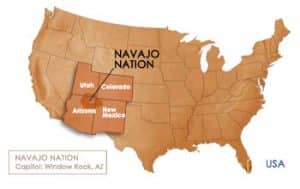 Water poverty in the U.S. is no different than water poverty in Africa. It affects absolutely every aspect of daily life, including physical and mental health, education, and economic viability. Just like African women and children who leave their homes each day to fetch unimproved water that is miles away, thousands of Navajo also make a daily journey in search of water. For the “fortunate” who own cars, they may drive to find water, although the gas expense is almost unbearable for many. For those without vehicles, they must walk miles — just like their African counterparts — to find water, sometimes getting the water from livestock troughs that are rife with bacteria and contaminants, other times getting water from unregulated wells and stock ponds.
Water poverty in the U.S. is no different than water poverty in Africa. It affects absolutely every aspect of daily life, including physical and mental health, education, and economic viability. Just like African women and children who leave their homes each day to fetch unimproved water that is miles away, thousands of Navajo also make a daily journey in search of water. For the “fortunate” who own cars, they may drive to find water, although the gas expense is almost unbearable for many. For those without vehicles, they must walk miles — just like their African counterparts — to find water, sometimes getting the water from livestock troughs that are rife with bacteria and contaminants, other times getting water from unregulated wells and stock ponds.
But the major difference between the African water crisis and the Navajo water crisis is that the Navajo live on the land of the richest nation on the planet. Chris Halter, director of Saint Bonaventure Indian Mission, has done work in some of the poorest parts of Africa and Latin America. Working in Navajo Nation for the past eight years, he notes, “It’s a third world country in the middle of the wealthiest country in the world.”
Uranium in Navajo water
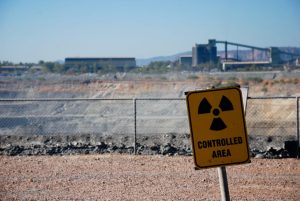
Not only do the Navajo have to travel for miles to find water, but the water they do find is often contaminated. As a result of the heavy mining that took place in the area during the nuclear arms race following World War II, much of the water found in Navajo Nation is heavily contaminated with uranium or other radioactive particles. After testing 240 unregulated sources on Navajo land, the EPA found that 10% of these sources had radioactive particles exceeding federal drinking water standards. It took decades for residents to learn the truly disastrous effects of this contamination, with family members suffering from kidney ailments and cancer. Prior to WWII, Navajo sheepherders and remote farmers procured water from communal wells close to their homes. But now, with poison snaking through their water supply and environmental officials instructing them to avoid drinking it, they travel hours for water.
The EPA, Indian Health Service, and the U.S. Department of Housing and Urban Development have dedicated $27 million to water system upgrades, including improving water quality for homes with existing running water, and adding piping to another 800 homes. However, it becomes prohibitively expensive to add piping to the more remote residences, so the EPA instead has paid for four tanker trucks to bring water to various meeting points once per week. Serving 3,000 homes, these trucks sometimes run dry before everyone has had a chance to receive their allotted water, and sometimes the road to reach the tanker is impassable. Some residents make the four-hour round trip drive to Flagstaff, Arizona to buy bottled water when it goes on sale for such emergencies, while still others do not have enough money for gasoline and have instead simply uncapped wells that have been deemed toxic. Nearly half of the remote residents have been visited by cancer, and tumors and kidney failure are routine ailments for the Navajo.
Gold King Mine spill contaminates Navajo Nation water supplies
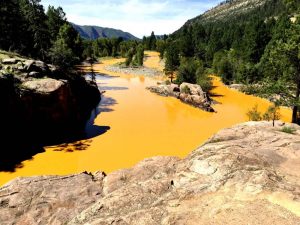
The Gold King Mine spill, which released three million gallons of water contaminated with lead, cadmium, arsenic, and other heavy metals into the Animas River in Colorado on August 5, has caused even further water woes for Navajo Nation. While the contamination is inconvenient for residents of the three states whose water supplies were affected by the spill, the impact to Navajo Nation is disastrous. Navajo Nation residents rely heavily on the water of the now contaminated San Juan River, into which the Animas River flows, for irrigation and livestock. Responding to alerts that the water is now toxic, the Navajo Farming Authority shut off all irrigation and intake points along the river. In the midst of their short farming season, farmers and ranchers are worried about finding ways to irrigate their crops and water their livestock. Clean water storage is being depleted at an alarming rate and Navajo Nation — not the EPA or the U.S. government — has had to shoulder the expense of additional water trucking. Navajo Nation President Russell Begaye is frustrated by the lack of response from the EPA, who, while inspecting the Gold King Mine, actually caused the toxic spill, and he is pleading for answers.
“Bottled water is becoming scarce, and my people want to know what we can drink after the clean supply runs out,” Begaye said. “We’re hauling water from wells outside the disaster area and using our own Navajo Nation funds to run these trucks back and forth. We desperately need help from outside to get good quality, safe drinking water.”
Added Begaye, “We are in the middle of farming season, which is only four to five months of the whole year, and farmers are begging me to help them save their crops, many of which are not fully ripe yet. The revenue from these crops is what our farmers need to live off for the rest of the year, so without irrigation water, they are doomed.”
What we can do to help
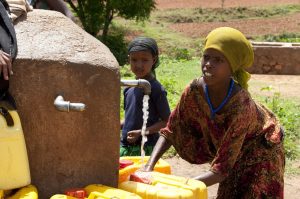 There are countless water charities that have been created in order to provide improved water and sanitation to developing countries. The Gates Foundation, water.org, charity:water, our own charity of choice, Water For People, and countless others all strive towards this lofty goal. But who is helping those suffering from water poverty right here on American soil? Until a few years ago, the answer was nobody — but that has changed.
There are countless water charities that have been created in order to provide improved water and sanitation to developing countries. The Gates Foundation, water.org, charity:water, our own charity of choice, Water For People, and countless others all strive towards this lofty goal. But who is helping those suffering from water poverty right here on American soil? Until a few years ago, the answer was nobody — but that has changed.
George McGraw is a human rights lawyer from Los Angeles and the founder of the non-profit DIGDEEP, which also provides water systems to developing countries. One day, McGraw received a phone call from a woman who wanted to make a contribution to DIGDEEP by sponsoring a well — but she had a stipulation. She told McGraw that she wanted her donation to be used in the United States. McGraw thought she was crazy, until she told him about Navajo Nation. And then he was just appalled.
“It really is an incredible injustice,” McGraw said. “If you’re born Navajo, you’re 67 times more likely not to have a tap or toilet in your house than if you’re born black, white, Asian, or Hispanic American.”
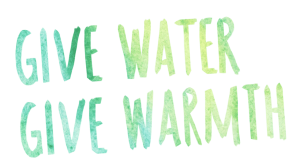 So McGraw founded the Navajo Water Project, a subsidiary of DIGDEEP that is dedicated to improving Navajo Nation’s water supply. With the Saint Bonaventure Indian Mission, they are raising funds to dig wells, buy water storage tanks, and install in-home plumbing for those suffering from water poverty in Navajo Nation. In addition, the Navajo Water Project sells Pendleton blankets, where for every purchased blanket, another blanket is donated to a Navajo family and $100 is donated to the Navajo Water Project.
So McGraw founded the Navajo Water Project, a subsidiary of DIGDEEP that is dedicated to improving Navajo Nation’s water supply. With the Saint Bonaventure Indian Mission, they are raising funds to dig wells, buy water storage tanks, and install in-home plumbing for those suffering from water poverty in Navajo Nation. In addition, the Navajo Water Project sells Pendleton blankets, where for every purchased blanket, another blanket is donated to a Navajo family and $100 is donated to the Navajo Water Project.
And every little bit helps. Our nation’s claim of 100% improved water and sanitation will not be a reality until every single person living on American soil has access to safe, clean water. The time to make that claim a reality is now. Visit www.navajowaterproject.org for more information.
UPDATE: Tata & Howard employee-owners recently donated over $2,000 to the Navajo Water Project. Read the press release here.
